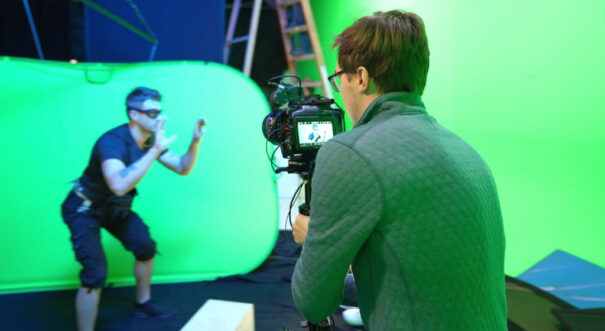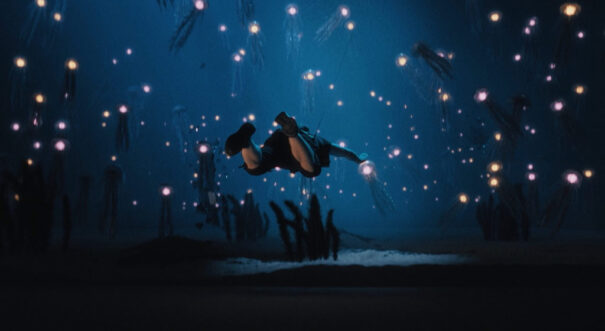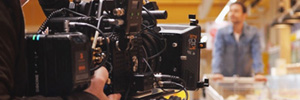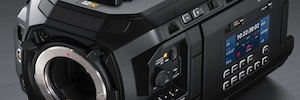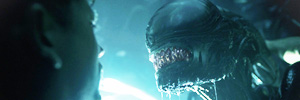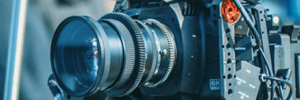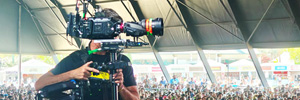Sokrispymedia and Samsung create viral video ‘Movie Effects Gone Wrong’ using Blackmagic Design
Sokrispymedia, in partnership with Samsung, created its newest viral video ‘Movie Effects Gone Wrong’ using Pocket Cinema Camera 6K Pro, URSA Mini Pro 12K and URSA Mini Pro 4.6K G2 digital film cameras and DaVinci Resolve Studio (Blackmagic Design).
Sokrispymedia’s Creative Director and Co founder Sam Wickert directed the story, which follows an action hero who ends up in a hilarious and thrilling chase sequence through a film studio backlot. The film, created to promote the Samsung T7 Shield Portable SSD, combines a mix of traditional production, stunts and incredible visual effects and is one of the most ambitious productions to date for the company.
Producer Lance B. Witmer was excited from the start to be pushing the envelope for Sokrispymedia. “One of the dynamics that sets this project apart from our past films is the premise,” said Witmer. “The whole story unfolds and then unravels across an entire studio backlot and multiple genre film sets, on top of all the craziness and action that we love. The film consists of seven distinct sets, wire stunts, vehicle stunts, a foot chase, a fight sequence and one of the largest crews we’ve pulled together, shooting for five consecutive days in two locations across Los Angeles, and that’s just the practical elements of physical production before VFX.”
Production shot portions of the project with the three Blackmagic Design cameras, relying on the smaller form factors to help expedite the challenging schedule. “We moved fast on this one, even faster than usual, which is saying a lot,” said Wickert. “As always, we love the Blackmagic cameras because they are easy to move with quickly, without the need for a lot of support equipment, while still getting a high cinema quality image.”
The partnership with Samsung proved to be advantageous for production as well.
“We recorded directly to the Samsung T7 Shield Portable SSDs from the URSA Mini Pro, the 12K and Pocket 6K Pro, which meant we had Blackmagic RAW files fed into editorial even while we were still on set,” continued Wickert. “These drives were fast enough to handle recording footage on the URSA Mini Pro12K even at the full 12,288 x 6480 resolution, which for us was amazing and didn’t force us to limit ourselves to a lower resolution because of read/write speed.”
Using Blackmagic Cloud, the team was able to start cutting sequences while still shooting to make sure they didn’t miss a shot. “It was critical not just to have a temp cut going but also for our VFX Supervisor Brendan Forde to track visual effects shots, ensuring he was getting the information he needed,” said Executive Producer Micah Malinics.
Photorealism
Forde knew the key to the success of the piece was photorealism. “All the effects have to sit well on our footage plates,” said Forde. “This required being on top of production, scanning sets and capturing plenty of lighting references to ensure we could digitally recreate the scenes. Being able to track shots in the constantly evolving Resolve project using Blackmagic Cloud was the key to it all.”
Rough cuts were produced on location in DaVinci Resolve Studio by editor Joshua Cole, who during shooting often sat behind the camera on his laptop to work. He copied camera footage directly to the Samsung T7 Shield Portable SSDs which acted as shared media in DaVinci Resolve Studio for both himself and later Wickert, who would review the cut at the end of the day to ensure it was playing well.
For post production, the team created over 100 computer generated shots for the 12 minute film, relying on DaVinci Resolve Studio and Blackmagic Cloud collaboration to help them stay up to date on cuts. The bulk of the shots were also composited in both Fusion Studio VFX and motion graphics software and the Fusion page within DaVinci Resolve Studio.
For Wickert, the most rewarding and challenging scene involved a photorealistic snake, and he noted, “The CG snake needed to grow to be 50 feet long inside a plane cabin. We spent a lot of time perfecting the snake model and animation to ensure it would play well, and we’re happy this ambitious scene turned out so realistic on screen.”
As one of its most ambitious projects to date, Malinics appreciated the company’s focus on using modern tools to not only speed up the process of filmmaking but also help maintain a high quality. “We’ve been evolving and finding more and more ways to improve our pipeline and deliver stunning shots in shorter turnarounds,” said Malinics. “A lot of times our breakthroughs and growth as filmmakers come in real production environments where we learn how to adapt to situations and deliver. As always, we rely on Blackmagic Design products to help us make it all happen
Gostou deste artigo?
Subscreva o nosso Alimentação e você não vai perder nada.



